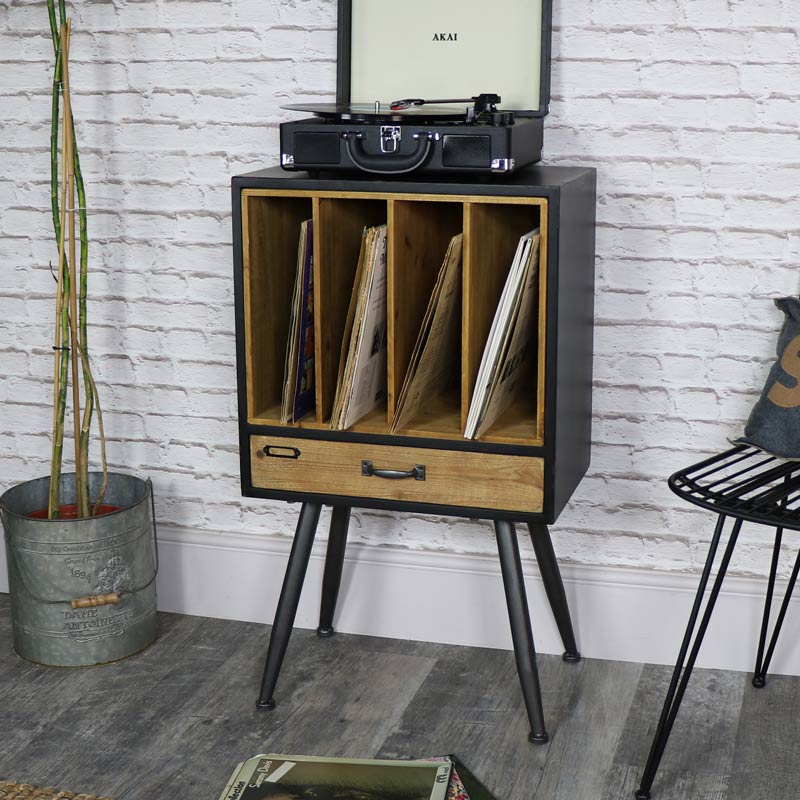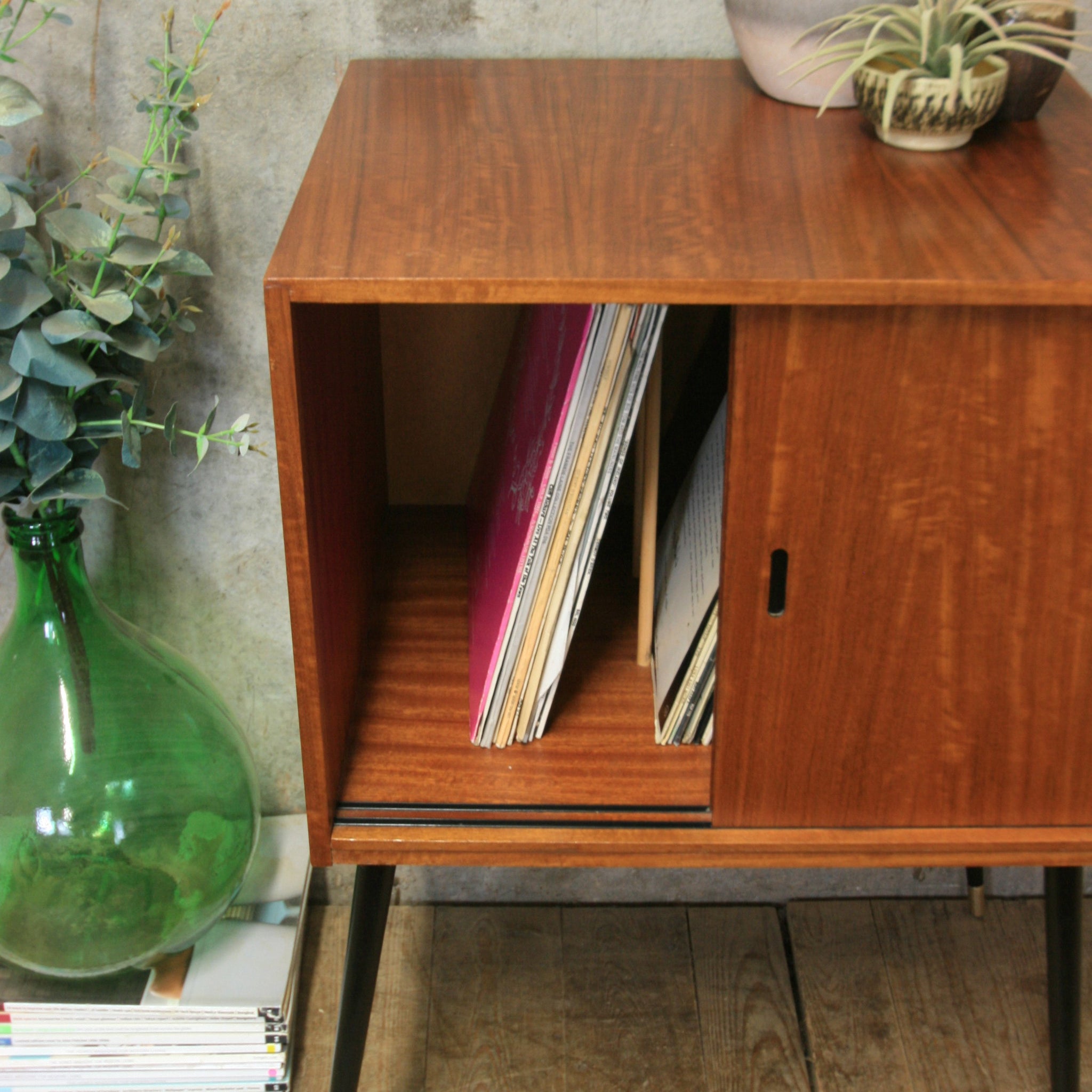The Appeal of Retro Record Storage Cabinets

The resurgence of vinyl records has sparked a renewed interest in stylish storage solutions, and retro record storage cabinets have emerged as a popular choice. These cabinets offer a unique blend of functionality and aesthetics, appealing to both audiophiles and design enthusiasts.
Aesthetic Appeal of Retro Record Cabinets
Retro record cabinets stand out from modern storage options with their distinctive design elements. They often feature sleek lines, vibrant colors, and intricate details that evoke a sense of nostalgia. In contrast, modern storage solutions tend to prioritize minimalism and functionality, often lacking the character and charm of retro designs. For example, a vintage mid-century modern record cabinet with its warm wood tones and brass accents adds a touch of sophistication to any room, while a sleek, minimalist cabinet might feel sterile or impersonal. The vintage design complements the warmth and analog nature of vinyl records, creating a harmonious aesthetic that modern storage options often fail to achieve.
Nostalgic Value and Cultural Significance
Retro record cabinets hold significant nostalgic value, transporting us back to a time when music was experienced in a more tangible and immersive way. They serve as a reminder of a bygone era when music was a central part of social life and vinyl records were the primary means of listening. The cultural significance of retro design is further amplified by its association with iconic periods in history, such as the 1950s and 1960s. These periods were marked by significant cultural shifts and advancements in music, fashion, and design, and retro record cabinets embody the spirit of these times.
Comparison of Retro Cabinet Styles
The appeal of retro record cabinets lies in their diverse styles, each offering a unique aesthetic and functional advantage. The following table compares the pros and cons of different retro cabinet styles:
| Style | Pros | Cons |
|---|---|---|
| Mid-Century Modern | Sleek lines, warm wood tones, timeless design | May be more expensive than other styles |
| Art Deco | Geometric patterns, luxurious materials, bold colors | Can be overwhelming in smaller spaces |
| Vintage Industrial | Rustic charm, exposed metal accents, unique character | May require more maintenance |
Types of Retro Record Storage Cabinets

Retro record storage cabinets offer a blend of functionality and style, catering to the discerning audiophile and design enthusiast alike. These cabinets transcend mere storage solutions, becoming statement pieces that reflect a specific era and aesthetic.
Styles of Retro Record Storage Cabinets
Retro record storage cabinets come in various styles, each embodying a distinct era and design philosophy.
- Mid-Century Modern: Characterized by clean lines, geometric shapes, and a focus on functionality. Popular materials include teak, rosewood, and walnut. Iconic examples include the Eames Storage Unit (ESU) and the Jens Risom Credenza.
- Vintage: Encompassing a wide range of styles from the 1950s to the 1980s, vintage cabinets often feature ornate details, bold colors, and playful patterns. Examples include the “Shaker” style cabinets with simple, functional designs, and the “Hollywood Regency” style cabinets with glamorous and sophisticated aesthetics.
- Industrial: Inspired by industrial spaces, these cabinets often feature metal frames, exposed rivets, and a raw, unfinished look. They are often made from reclaimed materials like steel and wood, and may feature rolling casters for easy movement.
Iconic Record Cabinet Designs
The evolution of record storage has produced some truly iconic designs that remain sought-after today.
- The “Hi-Fi” Cabinet (1950s-1960s): These cabinets were designed specifically for housing record players, amplifiers, and speakers. They often featured a sleek, modern design and were made from high-quality materials like walnut and mahogany. The “Hi-Fi” cabinet was a symbol of the technological advancements and consumer culture of the era.
- The “Stereo Console” (1960s-1970s): These large, often modular cabinets housed entire stereo systems, including turntables, tape decks, and speakers. They were often made from wood veneer or plastic and featured a variety of finishes and colors. The “Stereo Console” was a popular choice for families and became a focal point of the living room.
- The “Record Rack” (1970s-1980s): As record players became smaller and more affordable, “Record Racks” emerged as a more compact and versatile storage solution. These racks were often made from metal or plastic and could be easily assembled and reconfigured. They were popular with music lovers who wanted a simple and functional way to store their vinyl collection.
Materials and Construction Techniques
Retro record storage cabinets are crafted from a range of materials, each contributing to their unique aesthetic and durability.
- Wood: Commonly used in mid-century modern and vintage cabinets, wood provides a warm and natural look. Popular woods include teak, rosewood, walnut, and mahogany. These woods are often finished with a natural oil or lacquer to enhance their beauty and protect them from damage.
- Metal: Industrial cabinets often feature metal frames and shelves, providing a sturdy and durable construction. Steel is a common choice for its strength and ability to be easily shaped and welded. Metal cabinets may also feature accents like exposed rivets and bolts, adding to their industrial aesthetic.
- Plastic: Some retro cabinets, particularly those from the 1970s and 1980s, were made from plastic. Plastic offered a more affordable and lightweight alternative to wood and metal, and it came in a wide variety of colors and finishes. Plastic cabinets were often designed to be modular, allowing them to be easily assembled and reconfigured.
Choosing the Right Retro Record Storage Cabinet

Selecting the perfect retro record storage cabinet is a journey of discovering the ideal blend of style, functionality, and practicality. It’s about finding a cabinet that complements your musical tastes, your home decor, and your record collection’s size.
Factors to Consider, Retro record storage cabinet
Several factors contribute to making the right choice. These considerations will guide you in finding a cabinet that seamlessly integrates with your lifestyle and aesthetic preferences.
- Size and Capacity: The cabinet’s dimensions are crucial. Measure your available space and consider the size of your record collection. A cabinet too small will leave you with limited storage, while a cabinet that’s too large might overwhelm the room.
- Features: Explore features like adjustable shelves, drawers, and doors. These features offer flexibility in organizing your records, ensuring they are easily accessible and protected.
- Material and Finish: The cabinet’s material and finish are important for its aesthetics and durability. Solid wood cabinets exude a classic charm and are built to last. Metal cabinets offer a more industrial vibe, while laminate cabinets are often more budget-friendly. The finish should complement your existing decor, creating a cohesive look.
- Budget: Set a realistic budget before you begin shopping. Retro record storage cabinets come in a wide range of prices, depending on materials, craftsmanship, and brand.
- Style: Consider your interior design style. A mid-century modern cabinet might suit a minimalist home, while a vintage-inspired cabinet would complement a more traditional setting. The cabinet’s style should complement your overall design aesthetic, creating a harmonious look.
Size, Capacity, and Features
The size and capacity of a retro record storage cabinet are essential considerations.
- Size: Measure the space where you intend to place the cabinet. Consider the width, depth, and height. Leave some clearance around the cabinet for easy access and movement.
- Capacity: Determine the number of records you need to store. Consider the size of your current collection and your future plans for expanding it. Choose a cabinet with enough shelves and drawers to accommodate your collection.
- Features: Features like adjustable shelves allow you to customize the cabinet’s interior to fit your needs. Drawers provide secure storage for smaller items, like accessories or vinyl cleaning supplies. Doors protect your records from dust and damage.
Material and Finish
The material and finish of a retro record storage cabinet play a significant role in its aesthetic appeal and durability.
- Material: Solid wood cabinets are known for their durability and timeless elegance. They often feature intricate details and craftsmanship, adding a touch of sophistication to any room. Metal cabinets offer a more industrial aesthetic, with their sleek lines and robust construction. Laminate cabinets are a budget-friendly option, available in a wide range of colors and finishes.
- Finish: The finish can dramatically impact the cabinet’s overall appearance. Popular finishes include natural wood stains, painted finishes, and metallic finishes. Choose a finish that complements your existing decor and personal style.
A retro record storage cabinet, with its sleek lines and vintage charm, can be a statement piece in any room. Its design often echoes the elegance of mid-century modern furniture, and its functionality allows for the organized display of cherished vinyl collections.
Similar to the functionality and aesthetic appeal of an oak and glass tv cabinet , a retro record storage cabinet can serve as a focal point, blending seamlessly into a modern or traditional setting. With its ability to hold both treasured vinyl and display decorative items, a retro record storage cabinet can be a versatile and captivating addition to any home.
The retro record storage cabinet, with its sleek lines and vintage charm, is a testament to a bygone era of music appreciation. Its design often echoes the aesthetics of mid-century modern furniture, a style that has seen a resurgence in recent years.
For those seeking to recreate that classic look in their living rooms, a mid-century TV cabinet can be a perfect complement. Mid-century TV cabinets in the UK offer a wide range of styles and materials, from sleek walnut to vibrant teak, allowing you to choose a piece that perfectly reflects your personal taste.
And just as a record storage cabinet houses a collection of cherished vinyl, a mid-century TV cabinet can become a focal point for your entertainment center, showcasing your curated taste in home décor.